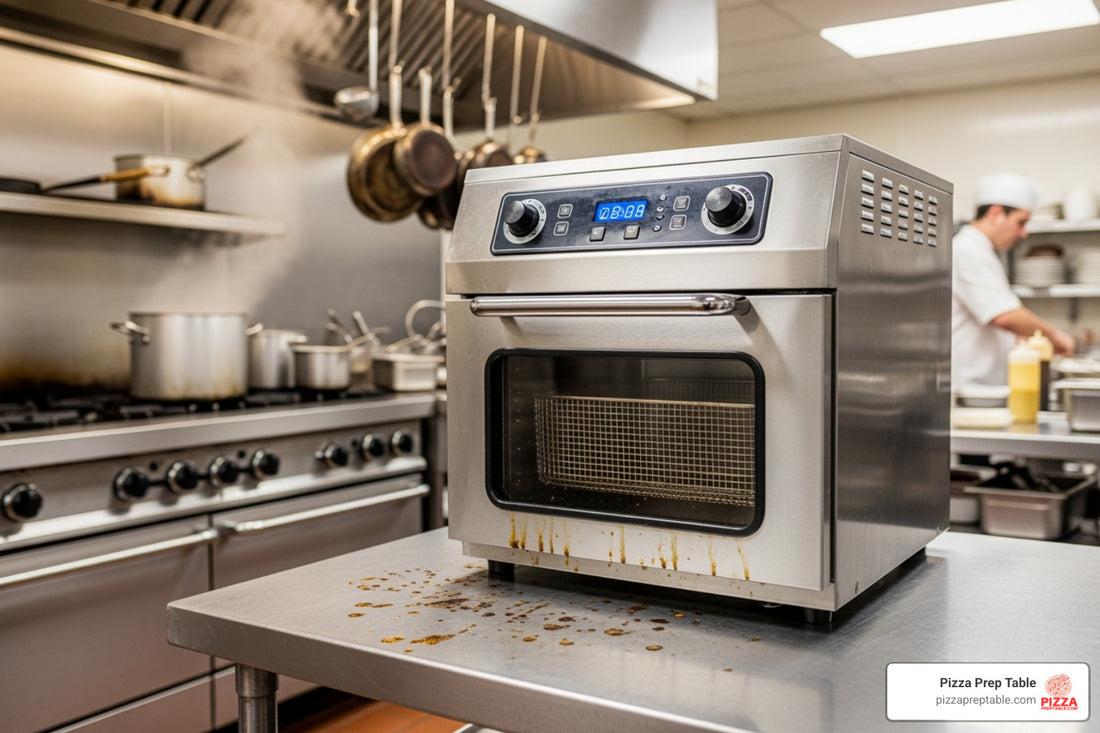
Is a Commercial Air Fryer Right for Your Business?
Share
Why Commercial Air Fryers Are Revolutionizing Restaurant Kitchens
A commercial air fryer is changing how restaurants cook fried foods by using forced hot air circulation instead of oil. These greaseless fryers can reduce fat content by up to 100% while maintaining the crispy texture customers expect. Here's what makes them different:
- Technology: Uses hot air circulation (360°) + radiant heat instead of oil submersion
- Health Benefits: Up to 100% less fat than traditional deep frying
- Safety: No hot oil burns or fire hazards
- Cost Savings: Up to 50% less energy consumption, eliminates oil purchasing
- Capacity Range: 2-50+ lbs depending on model type
- Ventilation: Many models are ventless, reducing installation costs
Key Types:
- Countertop models (2-10 lbs) - perfect for food trucks and small cafes
- Floor models (10-30+ lbs) - ideal for high-volume restaurants
- Double-decker units (20-50+ lbs) - maximum output in minimal space
The biggest advantage? You can expand your menu with healthier fried appetizers, entrees, and desserts without the safety risks and ongoing costs of traditional oil fryers.
As someone who's spent years in sales - from baseball cards in college to restaurant equipment today - I've seen how the right equipment transforms a kitchen's efficiency and profitability. Commercial air fryer technology represents one of the most significant advances in foodservice equipment, especially for pizzerias looking to diversify their menu safely and cost-effectively.
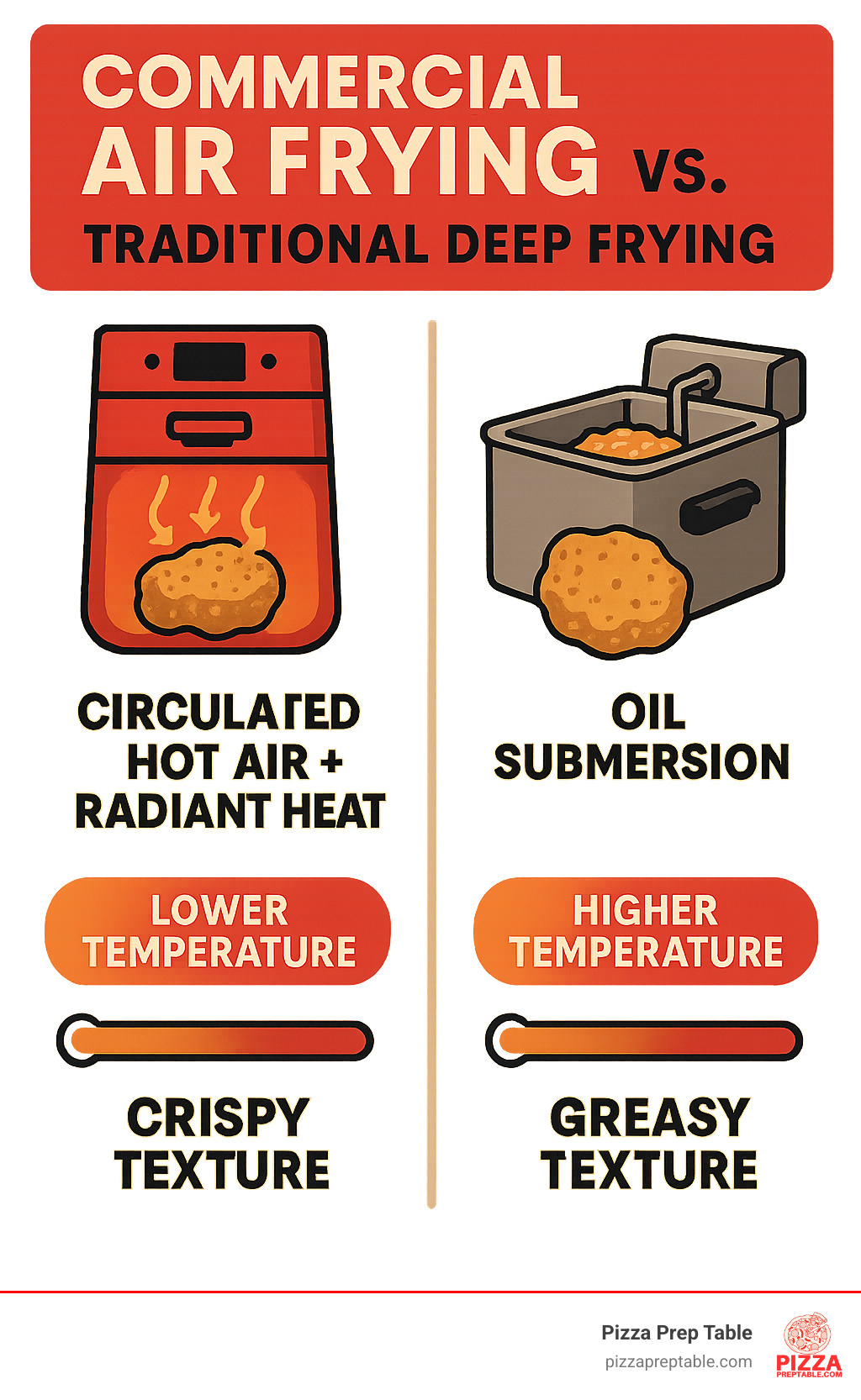
Commercial air fryer terms to know:
The Triple-Win: Health, Safety, and Cost Benefits
The beauty of a commercial air fryer lies in its ability to deliver three major wins for your restaurant: healthier food for your customers, a safer workplace for your staff, and real money savings for your business. It's like getting three pieces of equipment for the price of one.
Health and Menu Appeal
Today's diners want food that tastes amazing but doesn't leave them feeling guilty afterward. A commercial air fryer gives you exactly that superpower - creating crispy, golden food with up to 100% less fat than traditional deep frying.
Picture serving perfectly crisp French fries, golden chicken wings, or even desserts like churros that look and taste just like the deep-fried versions your customers love. The difference? They're made with hot air circulation instead of oil, so your customers get all the satisfaction without the heavy feeling afterward.
This opens up exciting menu possibilities. You can create healthier versions of classic fried appetizers, entrees, and desserts without losing that satisfying crunch. Whether you're catering to health-conscious diners, people with dietary restrictions, or just customers who want to indulge without overdoing it, air-fried options help you serve a wider audience.
The best part? Your food still looks Instagram-worthy and tastes indulgent. It's culinary magic that keeps customers coming back.
Improved Kitchen Safety and Environment
Let's be honest - traditional deep fryers can be scary. Hot oil bubbling away, the constant risk of splashes, and the very real danger of burns make them one of the more hazardous pieces of kitchen equipment.
A commercial air fryer changes all that by eliminating hot oil entirely. No oil means no oil burns, no dangerous splashes, and no risk of grease fires. Your kitchen staff can work with confidence instead of constantly watching out for hot oil hazards.
But the safety benefits go beyond just avoiding burns. Ventless air fryers don't send grease particles into the air or heat up your kitchen the way traditional fryers do. This creates a cooler, cleaner work environment that's more comfortable for your team and easier to maintain.
Without oil mist coating every surface, your kitchen stays cleaner throughout the day. You'll spend less time scrubbing down walls and equipment, and your ventilation system won't work as hard. It's a win for both cleanliness and comfort.
Unpacking the Cost-Saving Potential
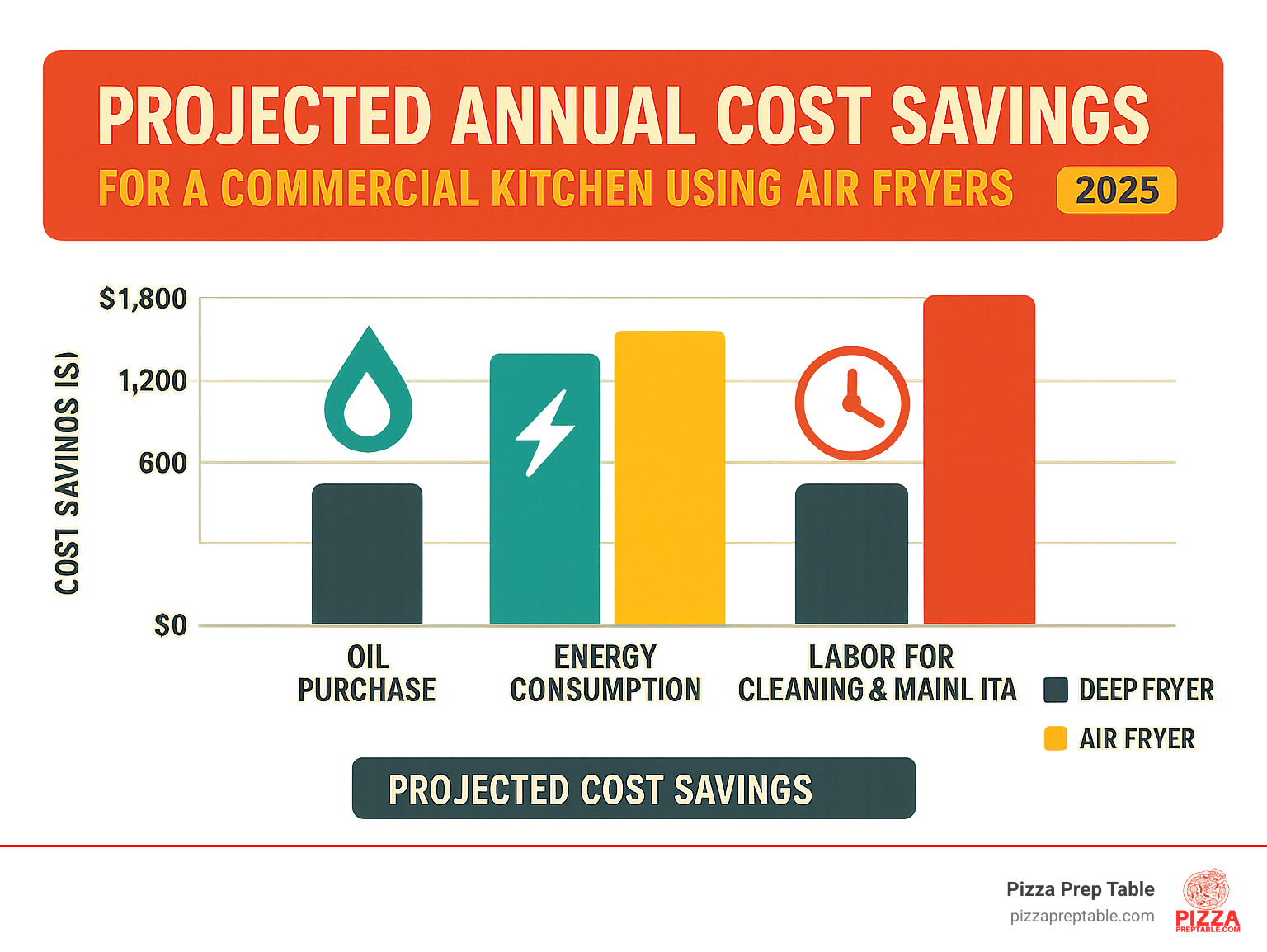
Here's where the commercial air fryer really shines from a business perspective. The cost savings are immediate and ongoing.
The biggest saving is obvious - no more oil purchases. Think about how much you spend on cooking oil each month, then multiply that by 12. That's money that stays in your pocket with an air fryer. Plus, you eliminate the hassle and cost of disposing of used oil.
Energy efficiency delivers another punch to your operating costs. Many air fryer models use up to 50% less energy than traditional deep fryers. Lower energy bills mean more profit without raising your menu prices.
Then there's labor savings. Without oil to manage, change, and clean up, your staff can focus on more productive tasks. Many air fryers have removable, dishwasher-safe parts and some even feature automatic cleaning cycles. Less time cleaning equipment means more time serving customers.
When you add up the savings on oil, energy, and labor, the numbers become pretty compelling. The commercial air fryer pays for itself through reduced operating costs while making your kitchen safer and your menu healthier.
For a deeper dive into how air fryers compare to traditional options, check out these helpful resources:
- Deep Fryers: Everything You Need to Know Before You Fry
- The Definitive Guide to Comparing Commercial Fryers
What to Look for When Choosing a Commercial Air Fryer
Finding the perfect commercial air fryer for your restaurant is like choosing the right teammate – you need someone who can handle your workload, fits in your space, and won't let you down during the dinner rush. Let me walk you through what really matters when making this important decision.
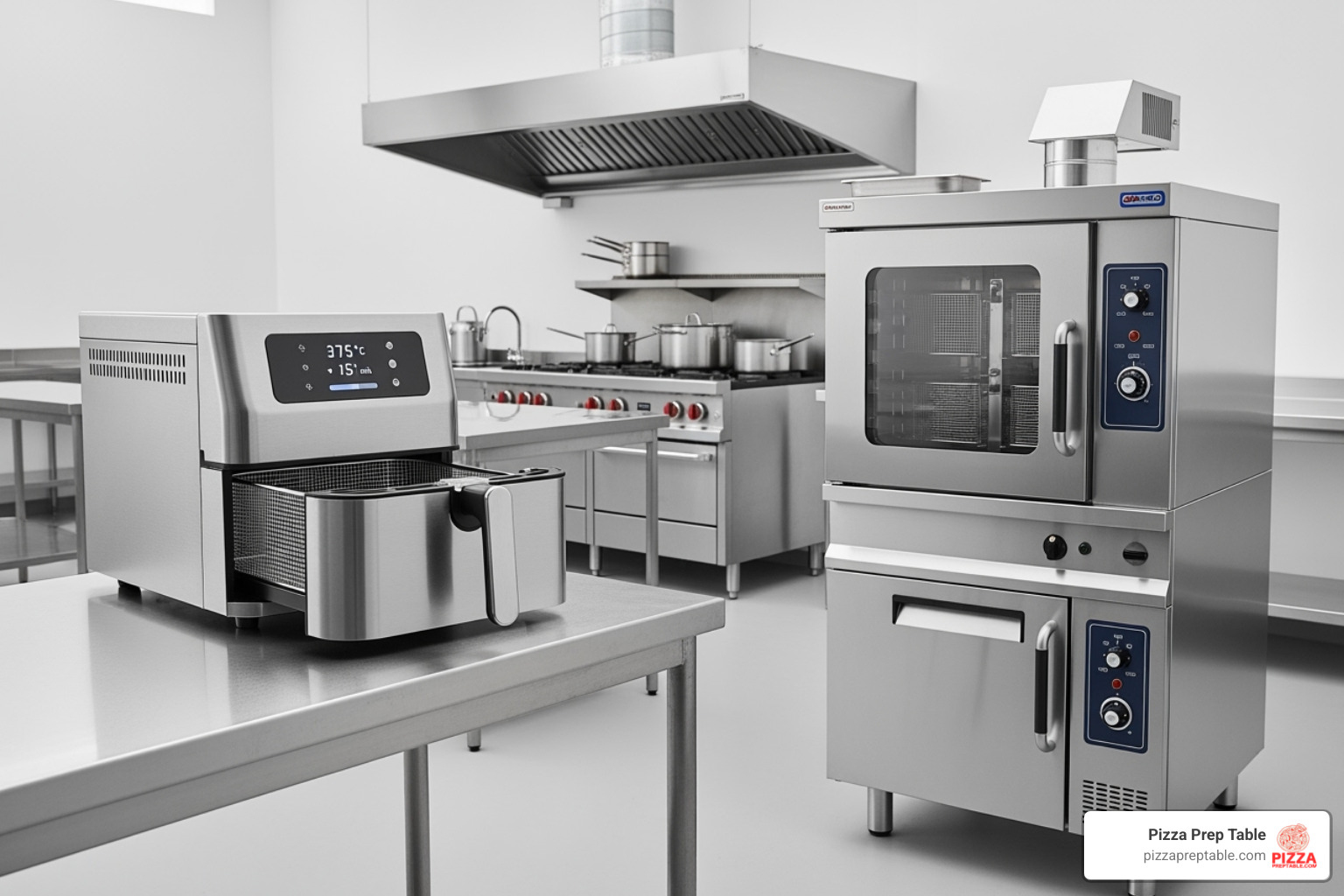
Understanding the Capacity of a Commercial Air Fryer
The first thing you need to nail down is capacity. Think about your busiest Friday night – how much fried food are you pushing out? This will determine whether you need a compact workhorse or a heavy-duty powerhouse.
Countertop models are the friendly neighborhood heroes of the air fryer world. With capacities ranging from 2 to 10 lbs per batch, they're perfect for food trucks, small cafes, or pizzerias wanting to test the waters with air-fried appetizers. Brands like VEVOR and BakeMax offer countertop units that can handle everything from a few orders of mozzarella sticks to a 4-pound chicken. These units won't dominate your prep space, but they'll definitely earn their keep.
When you're ready to play in the big leagues, floor models step up to the plate. These units can handle 10 to 30+ pounds per batch, making them ideal for high-volume restaurants and cafeterias. Leading brands like Quik n' Crispy and LightFry dominate this space with units that can keep up with even your hungriest crowds. Yes, they need more dedicated floor space, but the output makes it worthwhile.
Here's where it gets really interesting: double-decker air fryers are like getting two ovens in the footprint of one. These vertical units from companies like Quik n' Crispy can handle 20 to 50+ pounds while cooking two different items at different temperatures simultaneously. Imagine cranking out crispy wings on top while your mozzarella sticks get golden brown below – it's multitasking at its finest.
The key is being honest about your needs. If you're just adding a few air-fried items to your pizza menu, start smaller. But if you see air frying becoming a major part of your operation, invest in the capacity upfront. Trust me, upgrading later is always more expensive than getting it right the first time.
Power, Controls, and Modern Technology
Now let's talk about the brains and brawn of your commercial air fryer. Just like a great pizza oven needs the right heat and control, your air fryer needs proper power and smart controls to deliver consistent results.
Power requirements are non-negotiable – get this wrong and you'll have an expensive paperweight. Most commercial units need 208V or 240V power, with wattage ranging from 1400W to over 5760W. The Quik n' Crispy GF5, for example, requires 208V/240V, 60Hz, single phase. Before you fall in love with any unit, make sure your kitchen can actually power it. Nobody wants to find electrical incompatibility after delivery day.
The control systems on modern air fryers are where the magic happens. Digital controls with LCD touchscreens give you precise temperature and timing control, while traditional manual controls with knobs and dials keep things simple and reliable. Both have their place, but digital usually wins for consistency.
Here's where technology gets exciting: smart menus and pre-programmed recipes. The LightFry units can store up to 30 preprogrammed menu items, meaning your staff can nail perfect wings or fries with just one touch. Some models offer over 100 recipes and cooking modes, which is like having a sous chef built right in. This isn't just convenient – it's a game-changer for training new staff and maintaining quality across different shifts.
Automatic cleaning cycles deserve special mention because nobody got into the restaurant business to scrub equipment all night. Models with one-touch wash programs, like LightFry's system with multiple settings (one-hour for light cleaning, four-hour for deep end-of-day cleaning), can save your team hours of labor weekly.
Some cutting-edge models even include USB ports for recipe updates, keeping your equipment current as your menu evolves. It's like having a smartphone that happens to make incredible fried food.
Comparing Commercial Air Fryer Types
| Feature | Countertop Air Fryer | Floor Model Air Fryer | Double-Decker Air Fryer |
|---|---|---|---|
| Capacity | 2-10 lbs | 10-30+ lbs | 20-50+ lbs |
| Footprint | Small | Large | Large (Vertical) |
| Best For | Food trucks, bars, small cafes | High-volume restaurants, cafeterias | Kitchens needing high output at different temperatures |
| Brands | VEVOR, BakeMax | LightFry, Quik n' Crispy | Quik n' Crispy |
The bottom line? Choose a commercial air fryer that matches your volume, fits your space, and has the technological features that will make your team's life easier. When you get these fundamentals right, you're setting yourself up for success in the exciting world of healthier fried foods.
Maintenance, Cleaning, and Long-Term Durability
Let's be honest – nobody gets into the restaurant business because they love cleaning equipment. But here's the good news: maintaining your commercial air fryer is surprisingly straightforward, especially compared to the daily oil-changing nightmare of traditional deep fryers. Think of it as the difference between wiping down a counter versus scrubbing burnt cheese off a pizza stone – one is clearly easier than the other!
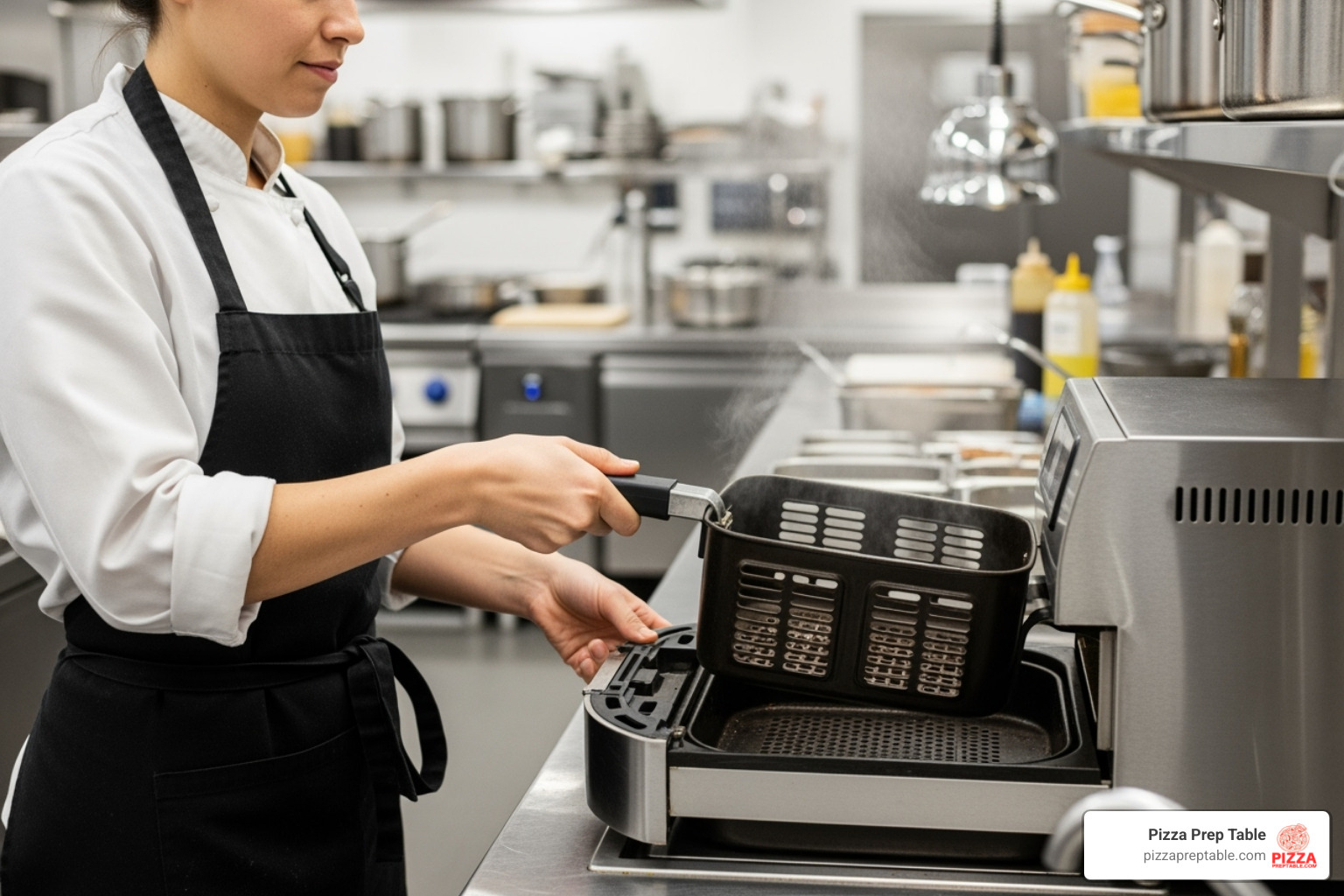
Daily and Weekly Cleaning Routines
The beauty of greaseless frying technology becomes crystal clear when it's time to clean up. Without gallons of hot oil to drain, filter, and dispose of, your daily routine becomes refreshingly simple.
Most commercial air fryer units are designed with busy kitchen crews in mind. The removable trays and non-stick interiors make cleaning easy – and I mean genuinely easy, not "easy" in the way that assembling furniture is supposedly easy. After each shift, you'll simply remove the cooking baskets and drip trays for a quick wash with warm, soapy water. Many of these components are dishwasher safe, which means you can toss them in with your other dishes and move on to more important tasks.
For the interior, a simple wipe-down with a damp cloth handles any food particles or residue. The non-stick surfaces mean you won't be scraping and scrubbing like you would with traditional fryers. It's more like cleaning a well-seasoned cast iron pan than dealing with baked-on grease.
Weekly maintenance steps things up slightly but remains manageable. Filter cleaning becomes your main focus – these should be cleaned weekly and replaced every 1-3 months depending on how busy your kitchen gets. Some advanced models, like the LightFry, take this even further with automatic cleaning cycles. Their one-touch wash program can run anywhere from one hour for light daily cleaning to four hours for that thorough end-of-day deep clean. It's like having a dishwasher specifically for your fryer.
Assessing the Long-Term Value of a Commercial Air Fryer
When we talk about long-term value, we're really talking about whether this equipment will still be making you money years down the road. The good news? Commercial air fryer technology is built for the long haul.
Warranty coverage gives you a clear picture of manufacturer confidence. Take the Quik n' Crispy® GF5 Air Fryer, which comes with a 1-year limited warranty on parts and 90-day limited warranty on labor. While that might seem standard, you're dealing with equipment that doesn't have the wear-and-tear issues of constantly heating and cooling massive amounts of oil.
Build quality matters tremendously in commercial kitchens, and most quality units feature stainless steel construction that can handle the daily grind. Stainless steel doesn't just look professional – it's genuinely easier to clean and won't corrode or stain like other materials might. After years of watching restaurant equipment come and go, I can tell you that this makes a real difference in longevity.
Here's something interesting: many models now feature toolless disassembly for cleaning. This isn't just a convenience feature – it's a durability feature. When your staff can easily take apart and properly clean equipment without hunting for tools or forcing connections, that equipment stays in better condition longer. It's the difference between regular oil changes and ignoring your car's maintenance schedule.
The elimination of hot oil creates a gentler operating environment for the equipment itself. No more constant heat stress from maintaining oil temperatures, no corrosive oil residue building up on internal components, and significantly reduced equipment turnover compared to traditional deep fryers. This translates directly into better return on investment and fewer surprise replacement costs.
For additional insights into commercial kitchen equipment standards and green practices, check out the Commercial Fryers | Office of General Services - NY.gov guidelines. And if you're transitioning from traditional fryers but still need to manage existing oil equipment, Keep Calm and Store On: Food Truck Fryer Oil Storage Tips offers practical advice for the transition period.
Frequently Asked Questions about Commercial Air Fryers
We get a lot of questions about these incredible machines, and honestly, I don't blame anyone for being curious! When you first hear about a commercial air fryer, it sounds almost too good to be true - crispy fried foods without the oil? Really? Let me share the answers to the most common questions we hear from pizzeria owners and food truck operators.
Can a commercial air fryer truly replace a deep fryer?
This is the big question everyone asks, and I'm happy to say the answer is yes, for most applications! The technology behind a commercial air fryer uses forced hot air, radiant heat, and specialized cooking baskets to create that perfect crispy texture we all love.
Here's what really impressed me when I first saw these units in action: they actually deliver on the promise of healthier versions of your signature fried appetizers, entrees, or desserts without compromising taste, appearance, or texture. Your customers won't feel like they're settling for a "healthy alternative" - they'll just enjoy great-tasting food that happens to have fewer calories and less fat.
The commercial air fryer really shines with frozen, oven-ready food items like French fries, chicken wings, egg rolls, and corn dogs. Take the Quik n' Crispy® GF5, for example - it can fry, grill, and bake a huge variety of oven-ready foods, giving you incredible versatility from one piece of equipment.
What about cooking speed? These units are remarkably efficient, able to prepare, heat, hold, and re-heat hundreds of foods in minutes. That's the kind of speed that keeps your customers happy during rush periods.
The versatility factor is another huge win. Beyond just frying, many models offer grilling, roasting, and baking functionalities. You're essentially getting multiple pieces of equipment rolled into one, which is perfect for kitchens where every square foot counts.
Now, I'll be honest with you - heavily battered items might still perform slightly better in traditional oil. But for the vast majority of menu items, a commercial air fryer delivers results that are remarkably close to deep frying, often with better texture and definitely with better health benefits.
Are ventless commercial air fryers really ventless?
I love this question because the answer sounds like magic, but it's actually solid engineering! Yes, ventless greaseless air fryers do not send grease particles into the air or heat up the work environment, making them a genuinely cleaner, safer, and more environmentally friendly alternative to standard deep-fat fryers.
The secret is in the built-in filtration systems. These sophisticated internal filters capture airborne particles and odors before they can escape into your kitchen. Since air frying involves hot air and sometimes steam (like in the LightFry's technology), effective steam capture is also built into the ventless design.
Here's something important though - while many commercial air fryer models are certified as ventless, you should always check with local health codes and fire regulations in your specific area. What's considered ventless in one city might have different requirements in another, so it's worth a quick call to your local health department.
The installation benefits are huge. Without needing a large overhead hood, you'll save significantly on installation costs and gain much more flexibility in your kitchen layout. This is especially valuable in smaller spaces like food trucks or compact pizzeria kitchens.
How much faster is a commercial air fryer than a convection oven?
While both use circulating hot air, a commercial air fryer is specifically designed to be faster and more efficient at achieving that perfect "fried" crispness, especially for certain foods.
The difference comes down to forced hot air technology. A commercial air fryer uses more powerful fans and concentrated airflow than a standard convection oven. This 360° hot air circulation ensures rapid, even cooking and achieves a crispier exterior much faster than general-purpose equipment.
Our research shows that commercial air fryers can be more efficient for heating up foods like french fries and chicken wings than a convection oven. That's because they're purpose-built to mimic the crisping action of deep frying, while convection ovens are designed for general cooking tasks.
One feature I find particularly clever is the refresh cycles that many units offer. These can restore crispness to products that have lost it, extending hold time. You won't find this specialized function in most convection ovens, and it's a game-changer for maintaining food quality during busy periods.
Think of it this way: a convection oven is like a reliable pickup truck - it can do many jobs well. A commercial air fryer is like a sports car - it's built specifically for speed and performance in achieving crispy, fried textures. Both have their place, but when you need that perfect crispy result fast, the air fryer is your champion.
Conclusion
After diving deep into commercial air fryers, one thing becomes crystal clear: these aren't just another piece of kitchen equipment – they're genuinely game-changing for restaurants looking to serve healthier food while boosting their bottom line.
Think about it. You're getting up to 100% less fat in your fried favorites, eliminating the constant worry of hot oil burns in your kitchen, and cutting operational costs dramatically by ditching expensive cooking oil altogether. Plus, with up to 50% less energy consumption, your utility bills get lighter too. It's like finding a piece of equipment that actually pays you back over time.
Whether you're running a busy pizzeria that wants to add crispy wings to the menu, or operating a food truck where every square inch and safety consideration matters, a commercial air fryer opens up possibilities you might not have considered before. Your staff works in a safer, cleaner environment. Your customers get the crispy textures they crave with fewer calories. And your accountant? Well, they'll probably smile when they see those reduced operating expenses.
The technological innovation we're seeing – from smart menus that remember your most popular recipes to automatic cleaning cycles that save hours of labor – shows this isn't just a trend. This is the future of frying in commercial kitchens.
At PizzaPrepTable.com, we've always believed in equipment that works as hard as you do. The commercial air fryer represents everything we love about modern foodservice innovation: it solves real problems, saves real money, and helps you serve better food to your customers.
Ready to see what else can transform your kitchen operations?
